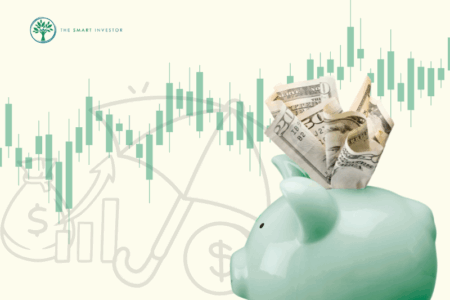The NASDAQ Composite Index soared to a record high last week.
You’ll either love or hate it.
If you are already invested, you are reaping the rewards with these gains. But if you’re not, then you may be regretting missing out.
Critics often greet market highs with scepticism, arguing that the US stock market is overvalued and is ripe for a correction.
While the cynicism holds some truth, it lacks specificity.
So, what about a recent example?
Stock market peaks from the past can provide us with clues about what to expect in the future.
On 19 November 2021, the NASDAQ index peaked at around 16,507, only to plummet 35 per cent by the end of 2022. The memory of this sharp decline is enough to send chills down the spine of even the most optimistic investor.
Indeed, the pain of watching your stocks turn red often lingers long after it happens.
But what’s less talked about is the fact that the NASDAQ index closed 20 per cent above its 2021 peak last Friday.
In other words, even if you bought at the peak three years ago, you would still be ahead today.
Still, critics remain unconvinced.
With the NASDAQ at an all-time high, they warn that over-optimism fuels stocks today, and they could fall as quickly as they rose.
In other words, stock prices don’t deserve to be as high today.
What causes stock prices to rise?
How do you determine whether a share price increase is justified, or not?
Here’s a simple framework: a stock price can be broken down into two key components, namely free cash flow (FCF) per share and the price-to-FCF (P/FCF) ratio.
Multiplying FCF per share by the P/FCF ratio gives you the share price.
This simple equation implies that the movement of either factor will have a direct and equal impact on the stock price.
But the similarity ends here.
In my view, the first factor, FCF per share, is a direct result of management’s effort.
A skilled management team will bring in revenue, keep costs and operating expenditures in check, and therefore, generate FCF.
If they keep doing well, the FCF per share will grow.
Returning to the equation above: if the FCF per share rises while the P/FCF ratio remains constant, the share price will increase proportionally with the FCF per share.
Under this scenario, the FCF per share, a proxy for the management’s efforts, is the primary driver.
We can’t say the same for the P/FCF ratio.
Unlike the FCF per share, the management has no control over where the multiple is trading.
A bullish market rewards stocks with higher P/FCF multiples while a bearish market reduces them. Hence, any gains driven by P/FCF growth are unreliable, as market sentiments can turn on a whim.
Are the stock price gains justified?
How can we test this framework?
Enter the Magnificent 7 stocks, namely Alphabet (NASDAQ: GOOGL), Amazon (NASDAQ: AMZN), Apple (NASDAQ: AAPL), Meta Platforms (NASDAQ: META), Microsoft (NASDAQ: MSFT), NVIDIA (NASDAQ: NVDA) and Tesla (NASDAQ: TSLA).
As of September 2024, this group collectively represented over 53 per cent of the NASDAQ index.
How have these shares fared since the 2021 market peak?
On average, the Magnificent 7 stocks have surged by 71 per cent with Nvidia being the outlier, scoring a staggering 347 per cent stock price gain.
Excluding Nvidia, the remaining six averaged a 25 per cent return, still higher than the market’s return.
Here’s the key question: were these gains justified?
To address this matter, I compared their stock price increases to the gains in their FCF per share and P/FCF ratio.
The table below shows whether each stock’s price rise was supported by FCF per share growth (justified) or simply benefitted from P/FCF expansion (unjustified).
| Stock | Ticker | Stock Price change (%) | FCF per share change (%) | P/FCF ratiochange (%) |
| Alphabet | GOOGL | 20% | -13% | 38% |
| Amazon | AMZN | 13% | -ve to +ve | -ve to +ve |
| Apple | AAPL | 41% | 20% | 17% |
| Meta Platforms | META | 71% | 60% | 6% |
| Microsoft | MSFT | 23% | 22% | 1% |
| Nvidia | NVDA | 347% | 606% | -37% |
| Tesla | TSLA | -15% | -14% | -1% |
Source: Company earnings releases, SEC filings and TIKR; Comparison period is from 19 November 2021 to 9 November 2024.
For simplicity, we will leave out Amazon as it does not have a usable value for its change in FCF per share and P/FCF ratio.
So, what can we learn from the above?
The stock price movements of five out of six stocks, excluding Alphabet, are primarily caused by the change in FCF per share.
For example, Meta and Microsoft’s stock price increase largely mirrors the growth in their FCF per share.
By the same measure, Tesla’s share price fell alongside the decline in its FCF per share.
Here’s the key lesson: given time, share prices will align with the change in their FCF per share, reflecting the management’s effort to grow the business.
The operative word here is time.
Three years have passed since the 2021 peak, providing ample time for the management to prove their worth. If they can grow the company’s FCF per share over this period, their efforts will eventually be recognised through a rising stock price.
A word of caution: while you should expect share prices to move alongside FCF per share, short-term stock price fluctuations are beyond your control.
Are stocks safe to buy today?
The table above provides you with a quick overview but does not consider other factors such as valuation.
For instance, Meta is trading at close to 30 times its trailing FCF today, a valuation can hardly be called cheap. Stretched valuations provide fodder for critics to warn about an overheated stock market.
They are right, to a certain extent.
If Meta does not grow as fast in the future, its stock multiple will fall, and so will its share price.
However, if Meta’s management team is able to increase its FCF per share by another 60 per cent over the next three years, the value created could lead to a higher stock price in future.
The key ingredient, again, is time.
Over the long term, if the management is able to increase the company’s FCF per share, you stand a better chance of coming out ahead down the road.
Get Smart: Heads, you win. Tails, you can buy some more
What can an investor do today?
Instead of worrying over what happens next, consider making a watchlist of stocks you will be happy to own. From there, you buy a little at the start, and if there is a better value point in the future, you can add to the stock again.
If you are already invested in stocks, consider keeping a small portion of your portfolio in cash.
That way, if the market rises, you are already invested and will gain. And if the market falls, you have some cash to pick up more shares at a discount.
Most importantly, always do what works for you.
Remember, you are successful when you achieve your own goals, not other people’s goals.
Note: An earlier version of this article appeared in The Business Times.
Attention Growth Investors: Our latest report, “The Rise of Titans,” gives you a front-row seat on the 7 most influential US stocks today. If you’re passionate about tech and growth, you can’t go wrong with our research. Downloading this FREE report could be the most strategic move you make this year. Click here to get started now.
Follow us on Facebook and Telegram for the latest investing news and analyses!
Disclosure: Chin Hui Leong owns shares of Alphabet, Amazon, Apple, Meta Platforms, and Microsoft.





